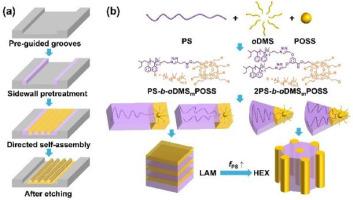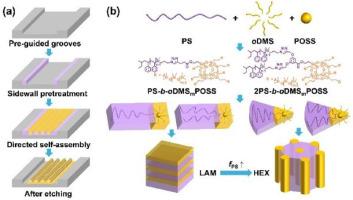Molecular architecture engineering of Oligo(dimethylsiloxane) functionalized giant surfactants for self-assembled Sub-10 nm nanostructures
IF 4.5
2区 化学
Q2 POLYMER SCIENCE
引用次数: 0
Abstract
Giant surfactants incorporating polyhedral oligomeric silsesquioxane (POSS) cages and tailorable polystyrene (PS) tails, were developed to achieve sub-10 nm nanostructures through molecular self-assembly. We have designed a series of giant surfactants by functionalizing POSS cages with oligo(dimethylsiloxane) (oDMS) ligands. Molecular architectures, including oDMS ligand lengths, the number of PS chain(s) and molecular weights were systematically synthesized to precisely control critical dimensions of self-assembled nanostructures. With changing those structural parameters, a phase transition from lamellar to hexagonal columnar structures was identified. Notably, the hexagonal columnar structures are practically important in direct self-assembly techniques. Furthermore, highly ordered sub-10 nm line patterns were successfully fabricated via spin-coating and reactive ion etching, providing molecular design strategies for advanced nanolithography. This study not only expands the structural design of giant surfactants but also demonstrates their promising applications in nanomanufacturing.


低聚二甲基硅氧烷功能化巨表面活性剂自组装亚- 10nm纳米结构的分子结构工程
采用多面体低聚硅氧烷(POSS)笼和可定制聚苯乙烯(PS)尾部的巨型表面活性剂,通过分子自组装获得了低于10 nm的纳米结构。我们用低聚二甲基硅氧烷(oDMS)配体功能化POSS笼,设计了一系列巨型表面活性剂。系统地合成了分子结构,包括oDMS配体长度、PS链数和分子量,以精确控制自组装纳米结构的临界尺寸。通过改变这些结构参数,确定了层状结构向六方柱状结构的相变。值得注意的是,六边形柱状结构在直接自组装技术中具有重要的实际意义。此外,通过旋涂和反应离子刻蚀,成功制备了高度有序的亚10nm线图,为先进的纳米光刻技术提供了分子设计策略。本研究不仅拓展了巨表面活性剂的结构设计,而且展示了巨表面活性剂在纳米制造中的应用前景。
本文章由计算机程序翻译,如有差异,请以英文原文为准。
求助全文
约1分钟内获得全文
求助全文
来源期刊

Polymer
化学-高分子科学
CiteScore
7.90
自引率
8.70%
发文量
959
审稿时长
32 days
期刊介绍:
Polymer is an interdisciplinary journal dedicated to publishing innovative and significant advances in Polymer Physics, Chemistry and Technology. We welcome submissions on polymer hybrids, nanocomposites, characterisation and self-assembly. Polymer also publishes work on the technological application of polymers in energy and optoelectronics.
The main scope is covered but not limited to the following core areas:
Polymer Materials
Nanocomposites and hybrid nanomaterials
Polymer blends, films, fibres, networks and porous materials
Physical Characterization
Characterisation, modelling and simulation* of molecular and materials properties in bulk, solution, and thin films
Polymer Engineering
Advanced multiscale processing methods
Polymer Synthesis, Modification and Self-assembly
Including designer polymer architectures, mechanisms and kinetics, and supramolecular polymerization
Technological Applications
Polymers for energy generation and storage
Polymer membranes for separation technology
Polymers for opto- and microelectronics.
 求助内容:
求助内容: 应助结果提醒方式:
应助结果提醒方式:


